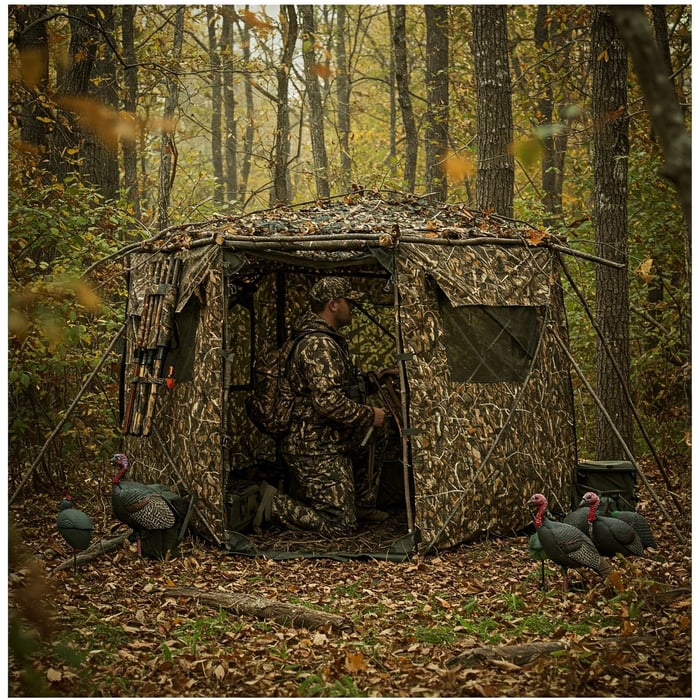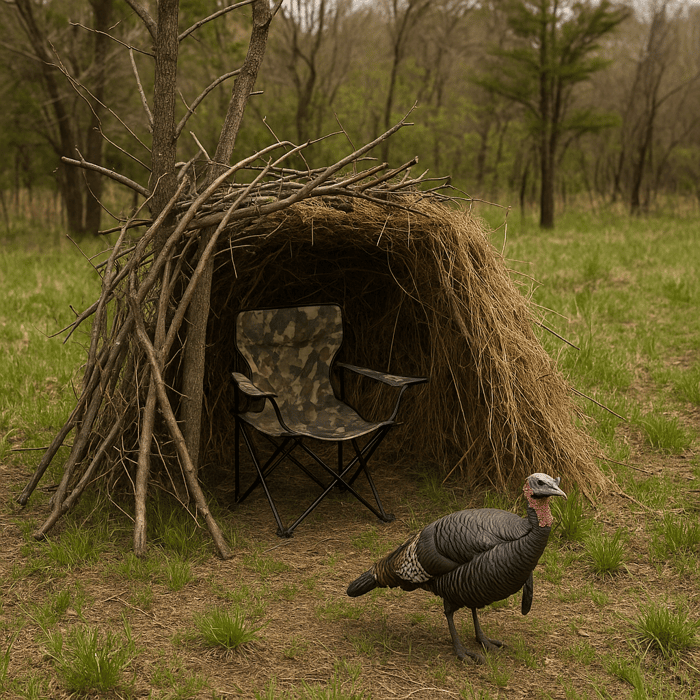Turkey hunting is an exhilarating experience that requires skill, patience, and a deep connection with the outdoors. Perhaps one of the most effective means of increasing your chances of getting a gobbler is to employ a DIY ground blind setup for turkey hunting. A ground blind makes it easy to remain concealed, remain comfortable, and approach those skittish birds. In this 3,000-word article, we're going to guide you through the entire process of making your own do-it-yourself ground blind system for turkey hunting, from selecting materials to deploying it in the field. Whether you're a new hunter or a pro, this article will provide you with useful advice to help your next hunt be a success.
Why Go for a DIY Ground Blind Setup for Turkey Hunting?
A homemade ground blind configuration for turkey hunting has a few benefits over purchasing one from a store. First, it's inexpensive. You can utilize materials you have at home or spend little money on hardware stores. Second, it's modular. You can configure your blind to conform to the ground, weather, and your approach. Lastly, there's pride in creating something with your own hands and employing it to fool a keen-eyed turkey.
Turkeys have amazing eyesight, so hiding is essential. A properly built DIY ground blind for turkey hunting camouflages itself in the surroundings, which makes it even more difficult for birds to find you. Moreover, it is a shelter against wind, rain, or sunshine, allowing you to remain longer in the field. Let us proceed with learning how you can build your own blind and put it up to get the most out of it.
Materials You'll Need for a DIY Ground Blind Setup for Turkey Hunting
Before you begin constructing your DIY ground blind setup for turkey hunting, have the proper materials. The idea is to make it simple, inexpensive, and functional. Here's what you'll need:
Basic Framework Materials
PVC pipes or stakes: These make up the frame of your blind. PVC is light yet strong, and wooden stakes are readily available and natural to camouflage.
Camouflage fabric or burlap: Use something that closely matches the color and pattern of your hunting ground. Camo netting is good too.
Zip ties, rope, or bungee cords: These tie the fabric onto the frame.
Tent pegs or stakes: To secure the blind to the ground and keep it stable.
Natural Camouflage for Your DIY Ground Blind Setup for Turkey Hunting
Branches, leaves, and grass: Gather natural elements from your location to improve cover.
Pruning shears: To cut branches or trim grass to fit your blind.
Optional Extras
Portable chair or stool: For comfort during prolonged sits.
Window mesh or one-way material: Enables you to look out without being seen.
Spray paint (natural colors): To camouflage PVC pipe or other man-made materials.
You don't have to break the bank. Most of these materials can be located at home, in nature, or in a local hardware store. The trick is to make a homemade ground blind arrangement for turkey hunting that's stable, mobile, and blends perfectly with your environment.
Step-by-Step Instructions on How to Create Your DIY Ground Blind Setup for Turkey Hunting
You now have your materials, so let's construct your DIY ground blind setup for turkey hunting. Follow the steps below to make a blind that is efficient and simple to set up.
Step 1: Plan Your Blind's Size and Shape
Prior to cutting or constructing, determine the size of blind you will need. A turkey hunting ground blind DIY system must be big enough to accommodate you, your equipment, and possibly a hunting companion, yet small enough to remain inconspicuous. Approximately 4 feet wide, 4 feet in depth, and 4–5 feet tall is an adequate size. It provides space to move and shoot your bow or shotgun without being too tight.
Draw a basic design on paper. Choose whether you'd like a box-shaped blind, a dome, or lean-to style. A box is simplest for a beginner, but a dome is more resistant to wind.
Step 2: Build the Frame
Start by creating the frame for your DIY ground blind setup for turkey hunting. If you’re using PVC pipes, cut them to size (e.g., 4-foot lengths for the sides and 5-foot lengths for the height). Connect the pipes using PVC elbow joints to form a square or rectangular base and top. For a wooden frame, drive stakes into the ground to form the corners, then tie or nail crossbars to create a stable structure.
Make sure the frame is sturdy but lightweight. You’ll need to carry it to your hunting spot, so avoid making it too heavy.
Step 3: Attach the Camouflage Material
Wrap your camouflage cloth, burlap, or netting around the frame. Hold it to the frame in place with zip ties, rope, or bungee cords. Provide holes for windows or shooting ports. These must be big enough to shoot through but small enough that you remain concealed. For a homemade ground blind configuration for turkey hunting, put mesh over the windows so that you can see out without being noticed.
Pro tip: Avoid stretching the cloth too much. A little relaxed fit is more natural and also mixes well with the surroundings.
Step 4: Add Natural Camouflage
To render your DIY ground blind cover for turkey hunting invisible in the environment, use natural materials. Mix branches, grass, or leaves into the netting or fabric. If in forest hunting, pine or oak branches are suitable. In a field setting, tall grass or corn stalks are suitable. The intention is to distort the outline of the blind and make it resemble part of the landscape.
Step 5: Test and Adjust
Prepare your DIY ground blind arrangement for turkey hunting in the house to test. Sit inside, rehearse pointing, and verify for visibility. Ensure that you are able to walk comfortably without making a rustling sound on the fabric or tipping the frame. If there is anything out of place, tweak the frame, fabric, or camouflage before venturing out into the field.
Selecting the Ideal Spot for Your DIY Ground Blind Setup for Turkey Hunting
Your DIY ground blind setup for turkey hunting is only as great as its location. Turkeys are wary animals, so selecting the ideal location is important. Here's how to select and prepare your hunting spot.
Scout Your Hunting Spot
Begin weeks prior to hunting season by exploring your hunting areas. Observe signs of turkey presence, such as tracks, droppings, feathers, or strut areas (locations where toms fan out to bring in hens). Take notice of roosting areas, feeding areas, and travel lanes. Your self-made ground blind setup for hunting turkeys ought to be placed along travel routes or near feed areas for success.
Consider Terrain and Cover
Select a location with natural cover, such as bushes, trees, or tall grass, to assist your blind in blending in. Steer clear of open spaces where your blind will be conspicuous. A small rise or dip in the ground can offer additional cover. For instance, placing your DIY ground blind configuration for turkey hunting at the boundary of a woodline facing a field is a timeless setup.
Consider Wind and Sun
Turkeys often move with the wind, so position your blind to take advantage of prevailing winds. This also keeps your scent from blowing toward the birds. Additionally, consider the sun’s position. Place your DIY ground blind setup for turkey hunting so the sun isn’t shining directly into your eyes or illuminating the blind’s interior, which could spook turkeys.
Setting Up Your DIY Ground Blind Setup for Turkey Hunting in the Field
Once you’ve chosen your location, it’s time to set up your DIY ground blind setup for turkey hunting in the field. Follow these tips to ensure your blind is ready for action.
Set Up Early
Ideally, place your blind several days or even weeks prior to your hunt. This allows turkeys to acclimate to it. If that is not feasible, place it at least the night before to cause minimal disturbance. A homemade ground blind installation for turkey hunting that has been established for a while appears as part of the landscape to cautious birds.
Anchor the Blind
Use stakes or tent pegs to secure your blind to the ground. This keeps it from swaying or toppling in the wind. For additional stability, heap dirt or rocks at the base of your DIY ground blind setup for turkey hunting.
Add Final Camouflage Touches
After your blind is installed, add additional camouflage from nature. Trim grass or branches from nearby (not miles, as it could appear artificial). Stuff them into the netting or material to disrupt the outline of your blind. Test your homemade ground blind setup for turkey hunting from a turkey's point of view—walk 20–30 yards back and ensure it will blend in.
Make a Comfortable Interior
Bring a folding chair or stool to sit on. Remove sticks or rocks within the blind so you don't make noise when you shift position. Position your equipment, such as calls, decoys, and snacks, so they are all accessible. An organized DIY ground blind setup for turkey hunting allows you to concentrate on the hunt, not messing around with your gear.
Tips for Hunting from Your DIY Ground Blind Setup for Turkey Hunting
With your DIY ground blind setup for turkey hunting ready, it’s time to hunt. Here are some tips to maximize your success.
Use Decoys Strategically
Decoys will entice turkeys within range. Position them 10–20 yards behind your homemade ground blind equipment for turkey hunting in an area where you have a clean shot. A hen decoy and jake or tom decoy combination can trigger interest or anger in a gobbler. Ensure the decoys are seen but not close enough to bring unwanted attention to your blind.
Master Your Calls
Turkey calls, like box calls, slate calls, or mouth diaphragms, are essential for luring birds. Practice your yelps, clucks, and purrs before the hunt. From inside your DIY ground blind setup for turkey hunting, keep calls soft and realistic to avoid sounding unnatural. If a tom responds, let him come to you—don’t overcall.
Stay Patient and Still
Turkeys have no rush to get up to you, so patience is the name of the game. Keep from moving unnecessarily, because even a twitch can scare off a bird. Your homemade ground blind for turkey hunting hides you, but you still must remain quiet and immobile. When you must shift position, do so slowly when the turkey is out of sight or behind cover.
Know Your Shooting Lanes
Before a turkey approaches, map out your shooting lanes—obstacle-free corridors where you have a clear path to shoot without any interference. Practice shooting through the windows of your DIY ground blind setup for turkey hunting to familiarize yourself with the equipment. When it is time to shoot, go for the head and neck to deliver a quick, humane kill.
Maintaining and Storing Your DIY Ground Blind Setup for Turkey Hunting
After the hunt, regular maintenance makes your DIY ground blind setup for turkey hunting last for several seasons.
Clean and Inspect
Clean dirt, leaves, or mud off the fabric and frame. Inspect for tears or loose joints. Fix any damage with duct tape, sewing, or replacement components. A well-maintained DIY ground blind setup for turkey hunting will be ready for your next hunt.
Store Properly
Keep your blind in a cool, dry location to avoid mold or mildew. Break down the frame if you can to conserve space. Store all parts together in a marked bag or box so you can quickly access them for the next hunt.
Common Mistakes to Avoid with Your DIY Ground Blind Setup for Turkey Hunting
Even with a wonderful DIY ground blind setup for turkey hunting, errors can cost you a trophy gobbler. Here are some traps to avoid:
Setting up too late: Turkeys take time to acclimatize to your blind, so don't leave setting it up until the morning of the hunt.
Poor camouflage: A visible blind will scare birds. Always camouflage using natural materials to blend in.
Noisy activity: Rustling clothing or squeaking chairs may warn turkeys. Test your equipment for sound prior to hunting.
Wrong spot: Positioning your DIY ground blind setup for turkey hunting too far from where turkeys are active decreases your odds. Scout extensively.
Why a DIY Ground Blind Setup for Turkey Hunting Is Worth the Effort
Constructing and employing a homemade ground blind system for turkey hunting is fulfilling on numerous levels. It is cost-saving, allows you to tailor your equipment, and enhances your bond with the hunt. And when you call in a gobbler and cleanly shoot one from a blind you constructed yourself, the feeling of satisfaction is indescribable.
This arrangement is also adaptable. Your DIY ground blind arrangement for turkey hunting can also be used for other species, such as deer or waterfowl, with slight modifications. It's a skill that improves with your time, allowing you to perfect your design each season.
Conclusion
A DIY ground blind arrangement for turkey hunting is a game changer for hunters seeking to remain concealed, comfortable, and efficient in the wild. By using this tutorial, you can construct a blind that's budget-friendly, easy to transport, and precisely tailored for your hunting technique. From selecting materials to deploying in the wilderness, each step guides you toward a successful turkey hunt. So take your equipment, recon your location, and prepare to build a DIY ground blind arrangement for turkey hunting that will aid you in outwitting even the most cautious gobbler. Good luck!





